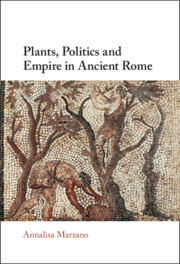Book contents
- Plants, Politics and Empire in Ancient Rome
- Plants, Politics and Empire in Ancient Rome
- Copyright page
- Dedication
- Contents
- Figures
- Tables
- Acknowledgments
- Abbreviations
- Introduction
- Chapter 1 Roman Gardens, Representation, and Politics
- Chapter 2 Arboriculture, ‘Botanical Imperialism’, and Plants on the Move
- Chapter 3 The Augustan ‘Horticultural Revolution’
- Chapter 4 Grafting Glory
- Chapter 5 Of Peaches and Peach Trees
- Chapter 6 Campania and Cisalpine Gaul:
- Chapter 7 Plant Dispersal and Provincial Agriculture
- Chapter 8 Viticulture versus Arboriculture
- Conclusions
- Bibliography
- Index
Chapter 6 - Campania and Cisalpine Gaul:
Developments in Commercial Arboriculture
Published online by Cambridge University Press: 06 October 2022
- Plants, Politics and Empire in Ancient Rome
- Plants, Politics and Empire in Ancient Rome
- Copyright page
- Dedication
- Contents
- Figures
- Tables
- Acknowledgments
- Abbreviations
- Introduction
- Chapter 1 Roman Gardens, Representation, and Politics
- Chapter 2 Arboriculture, ‘Botanical Imperialism’, and Plants on the Move
- Chapter 3 The Augustan ‘Horticultural Revolution’
- Chapter 4 Grafting Glory
- Chapter 5 Of Peaches and Peach Trees
- Chapter 6 Campania and Cisalpine Gaul:
- Chapter 7 Plant Dispersal and Provincial Agriculture
- Chapter 8 Viticulture versus Arboriculture
- Conclusions
- Bibliography
- Index
Summary
In this chapter, the literary, documentary, and archaeological evidence pertaining to horticulture and arboriculture in eastern Gallia Cisalpina and in Campania is investigated. The chapter argues that these two regions of Roman Italy played an important role for horticultural developments in the late Republic and early imperial era, both as producers of fruit and vegetables and possibly also as developers of new cultivars. The archaeobotanical record of Gallia Cisalpina also clearly shows that, from the Augustan era throughout the whole of the first century AD, the frequency and diversity of recovered remains of fruit greatly increased. These two regions had very important ports, Puteoli and Aquileia, which handled a large amount of trade coming from the rest of the Mediterranean and it is possible that these ports were entry routes into the wider region first, and the rest of Italy later, for new fruit trees coming from the eastern Mediterranean regions such as the peach, the apricot, and the citron/lemon.
Keywords
- Type
- Chapter
- Information
- Plants, Politics and Empire in Ancient Rome , pp. 198 - 232Publisher: Cambridge University PressPrint publication year: 2022

